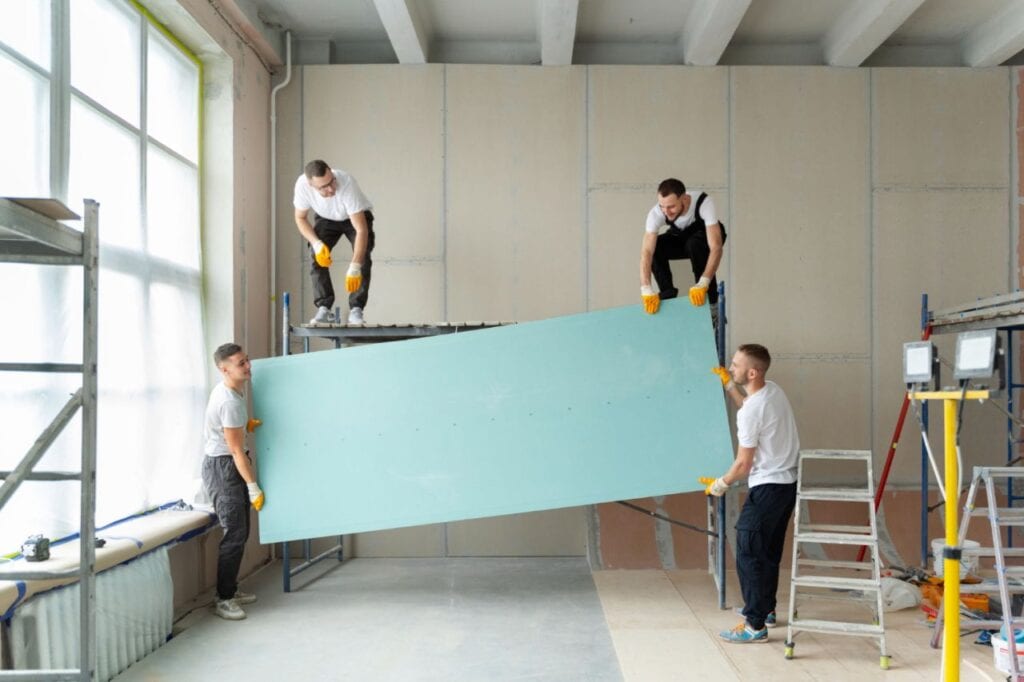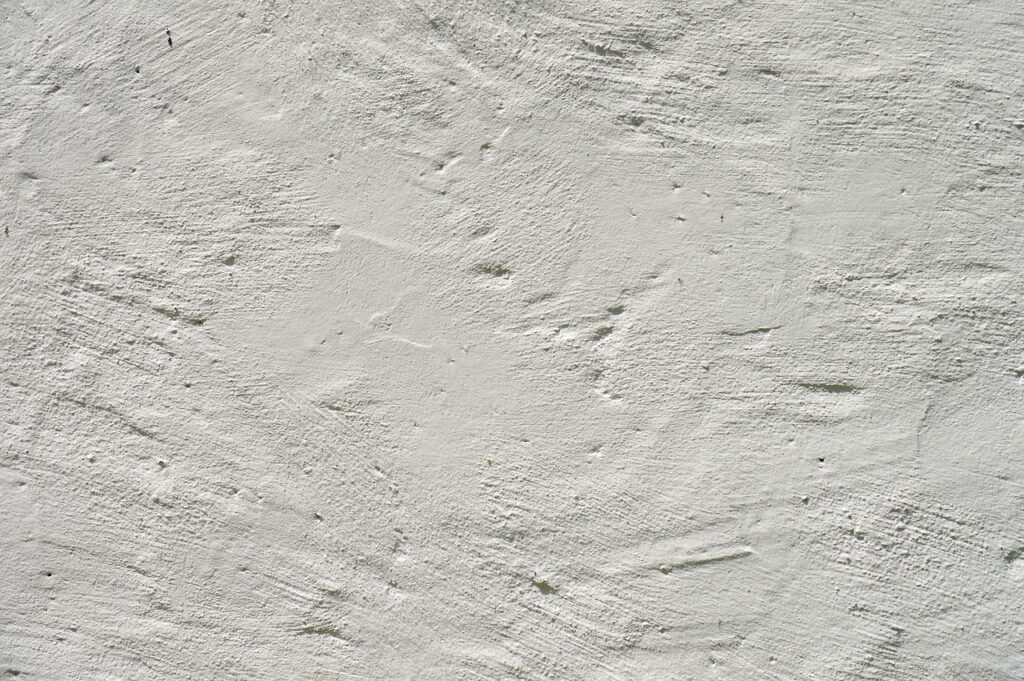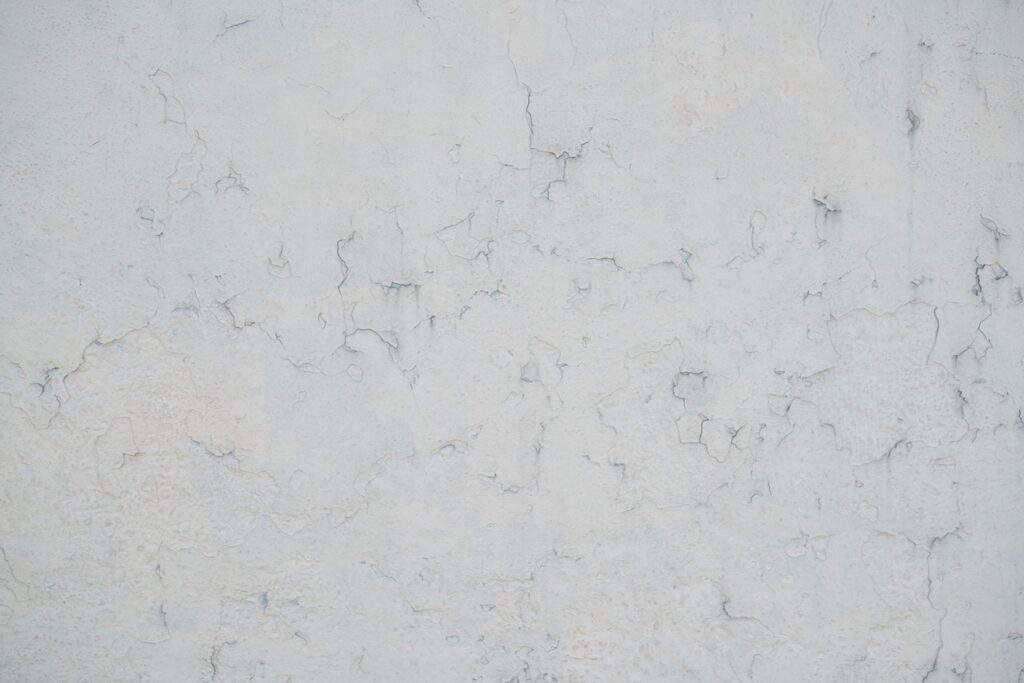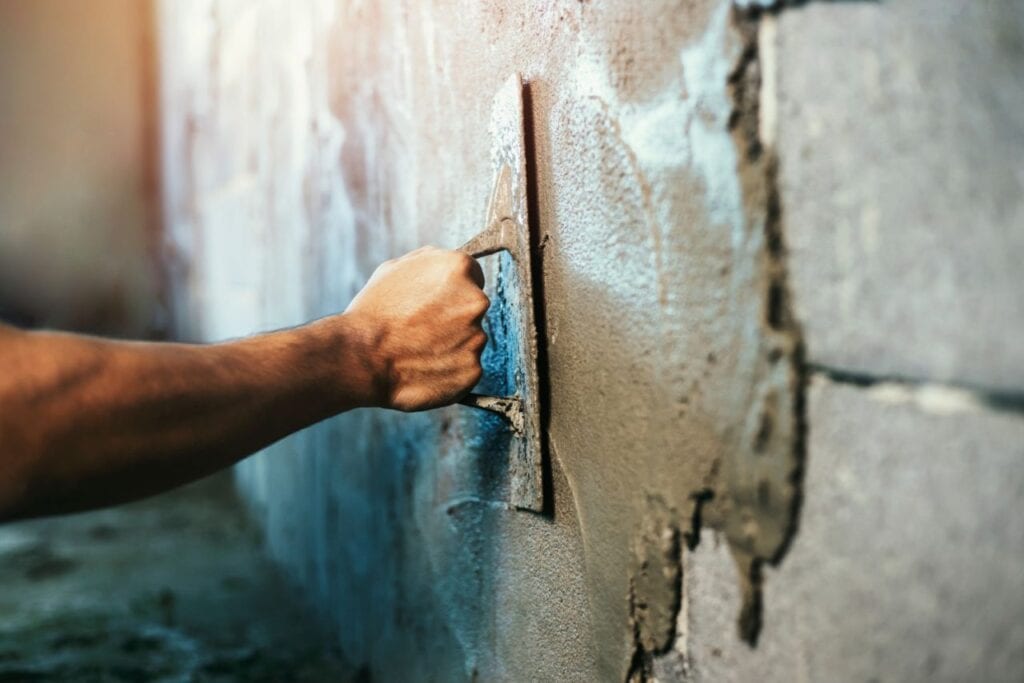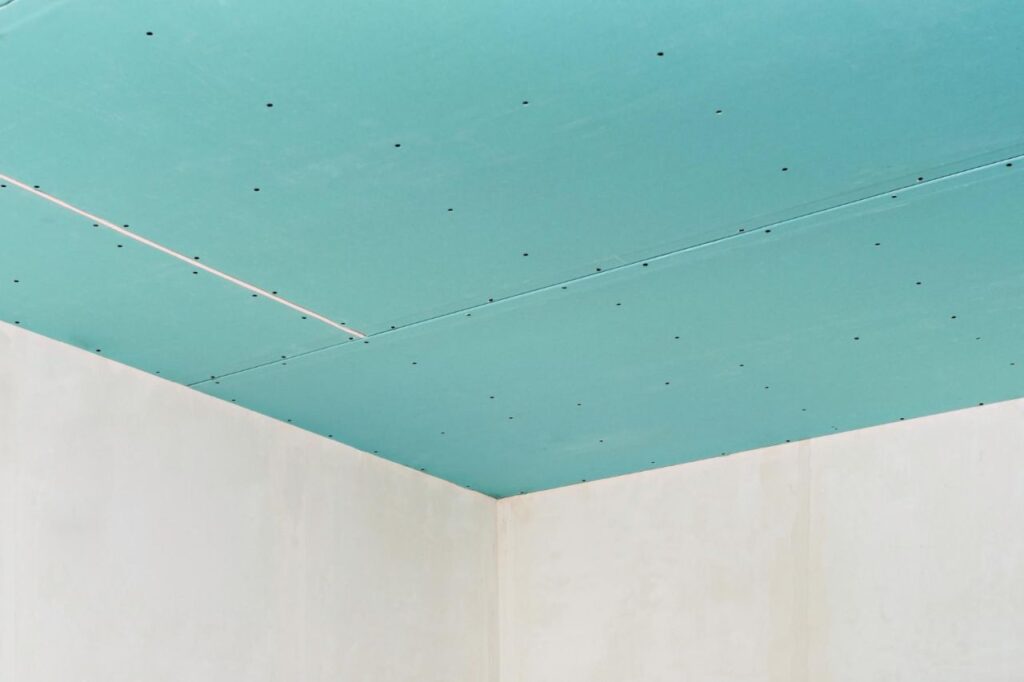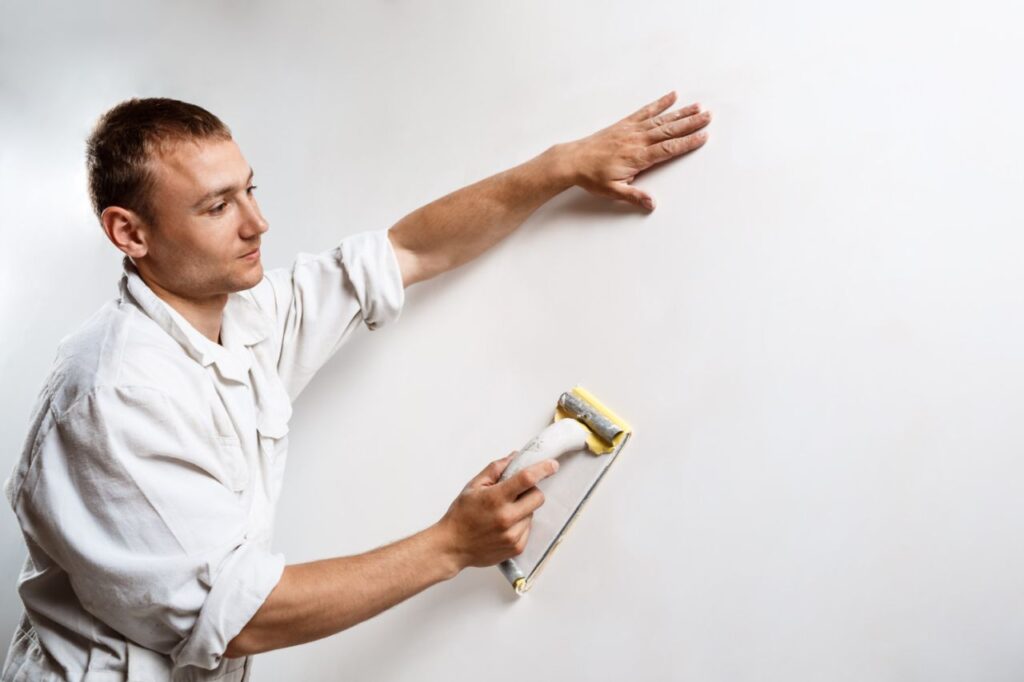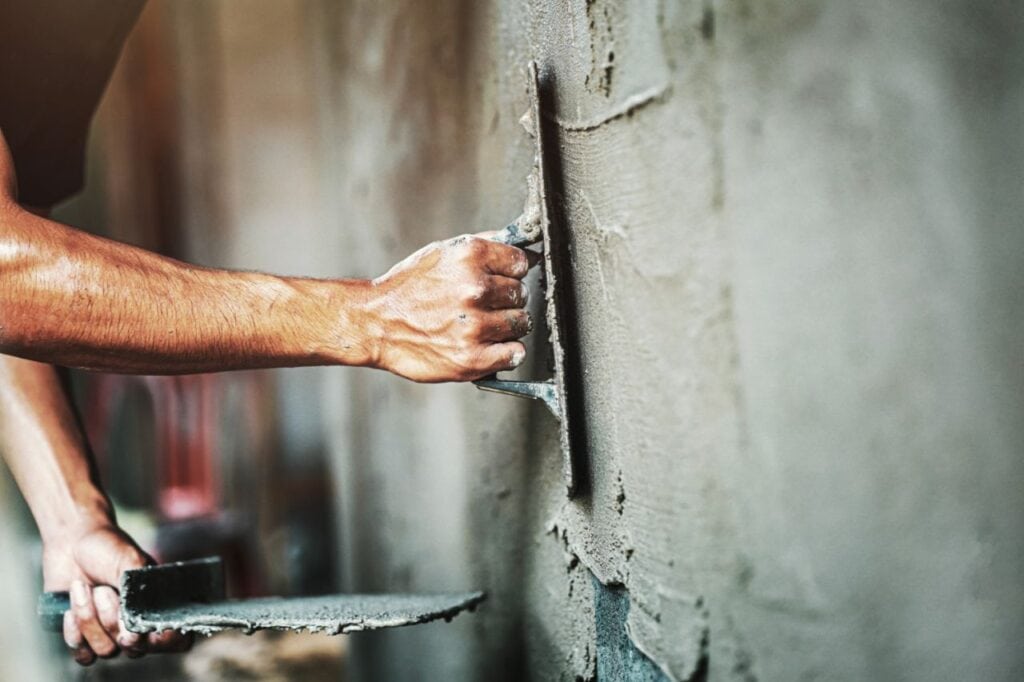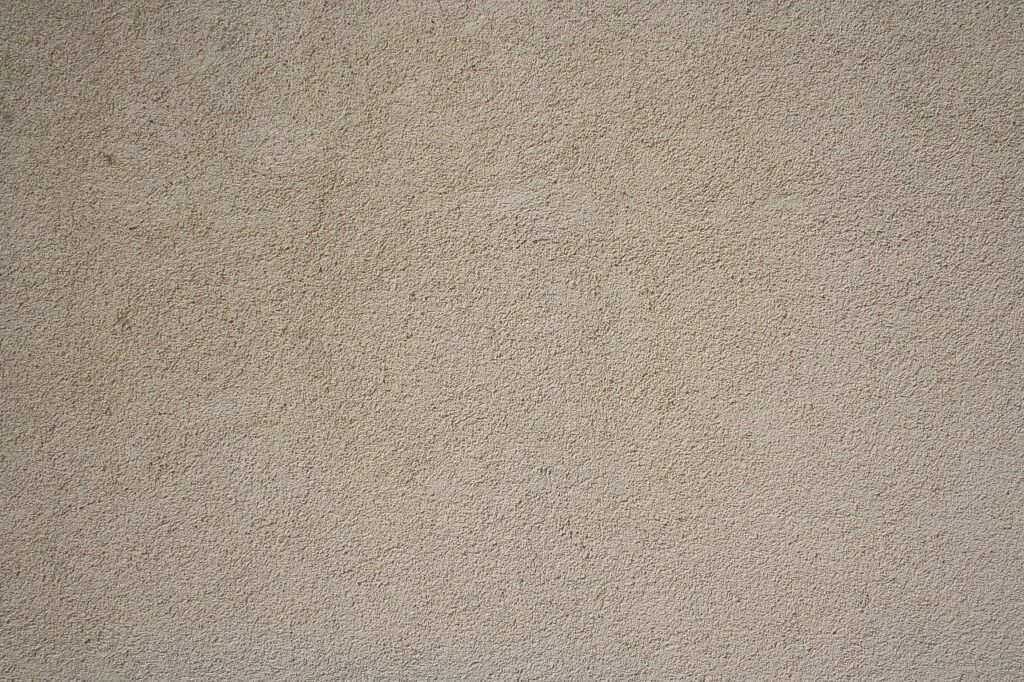Do you want to plaster your walls but need help deciding what kind to buy? Plastering the walls is an important part of any building or remodelling project, and the plaster materials you use make a significant difference in the result. However, the sheer number of solutions on the market makes it difficult to settle on the best one for any endeavour.
In this post, we will explore the various types of plasters available and assist you in making an informed decision about which plaster to use.
Plaster Types Used For Wall Plastering
Here, we'll explore the most common choices for finishing your interior walls with plaster, each with advantages and disadvantages.
If you are nearing the end of a home improvement or construction project, consider the various types of plaster available.
Plastering your walls is best left to the pros, but you should still educate yourself on the different kinds of plaster and how they might function in your home. In addition, it's important to investigate which ones go well with your specific property.
It's important to make sure the plaster you're using is appropriate for your home, but it's also interesting to note that different plasters perform better in different situations.
Here, we'll examine the most common plaster varieties and explain when and why each should be used.
When it comes to wall plastering, selecting the appropriate type of plaster is crucial for both aesthetic appeal and pest control. One recommended choice for wall plastering is cement plaster, also known as sand-cement plaster.
This durable and robust material provides a protective barrier against pests, strengthening the defence system of your walls. Cement plaster is highly resistant to water, making it less susceptible to damage caused by pests such as termites or ants.
By opting for cement plaster, you not only enhance the longevity of your walls but also create an inhospitable environment for pests, reducing the risk of infestations.
Cement Plaster
Cement plaster, in contrast to lime and gypsum plaster, consists of sand, cement, and water and is typically mixed on the job site. Cement plaster is frequently used because of its low price and fast setting times, but it is more difficult to smooth than gypsum plaster. Because of this, gypsum plaster is often used as a finishing coat.
Cement plaster is not appropriate for use in period homes because it does not breathe as well as lime plaster and is not as flexible.
Advantages Of Cement Plaster
The many advantages of cement plaster have made it a popular choice for plastering walls. The use of cement plaster has many advantages, including:
Cost-Effective: Cement plaster is one of the most affordable options available. In addition, its accessibility makes it a good choice for builders looking to save money.
Durability And strength: When looking for a finish on a wall that will last, cement plaster is hard to beat for its strength and durability. It is resistant to cracking, impact, and abrasion and can therefore withstand the pounding of foot traffic.
Versatility: Plaster made from cement is adaptable and can be applied to various materials. Its versatility as an interior and exterior walling material makes it a go-to for many construction companies.
Water And Fire Resistance: Cement plaster's high water and fire resistance makes it a good choice for high-risk environments. It's resistant to water and humidity, so you can confidently put it to use in high-humidity rooms like the kitchen or bathroom.
Easy To Apply: Cement plaster can be applied in one thin coat or several thicker ones to achieve different looks. In addition, builders can use either a trowel or a spray gun to apply it.
Disadvantages Of Cement Plaster

While there are many positives to using cement plaster, builders and homeowners should also be aware of a few disadvantages. The use of cement plaster has some drawbacks, including the following:
Prone To Cracking: Cement plaster, despite being strong and durable, can crack if not applied properly. To avoid cracking, ensure the surface is smooth and even, and apply the plaster evenly.
Slow Drying Time: The lengthy drying time of cement plaster can cause construction delays. Depending on its thickness and surrounding conditions, plaster may take several days to dry.
Health Concerns: Applying cement plaster with the necessary safety measures can help your health. It can irritate the eyes, the respiratory tract, and the skin. Wear protective gear when working with cement plaster, goggles, gloves, and a face mask.
Difficult To Repair: It can be challenging to repair cement plaster if it cracks or is otherwise damaged. Replastering an entire damaged area can be a time-consuming and expensive process.
Design Options Are Limited: The design potential of cement plaster is restricted. Only a few classic tones and finishes are typically on hand, limiting its applicability in some cases. Use a different kind of plaster if you want a more flexible finish.
Gypsum Plasters
Gypsum, a naturally occuring mineral compound, is used to create the highest quality hard plasters. Plasters made with gypsum are more durable than those made with calcium sulphate and are less prone to shrinking and expanding than Portland cement plasters.
Gypsum plasters are fragile, so they need to be mixed as soon as possible after being poured. Once wet, they harden quickly. If you want to plaster an area two feet by one inch, pour enough liquid plaster to cover the entire area by one inch. The plaster must dry for an entire day before you can touch it.
Three types of gypsum plaster are available, including natural, synthetic, and modified options. Natural gypsum plasters have very few additives. Up to 80% of synthetic gypsums are fillers. The additive content of modified gypsums can reach as high as 50%.
You may need to increase the limestone in your gypsum mix if you live in a particularly humid area. Limestone contributes to forming a durable finish on the plaster's outer layer. When applied correctly, this coating inhibits mould development and prevents the plaster from flaking.
Increase the amount of a quick-setting time ingredient, such as potassium aluminium sulphate, if you live in a particularly hot, arid climate. These can be added to plaster to make it more robust and waterproof.
More silica sand could be added for extra strength in cold climates. In addition, the alumina in silica sand and water causes the mixture to be relatively light. As a result, less strain is placed on load-bearing structures like wooden house frames when more weight is applied to them.
Advantages Of Gypsum Plaster
Plastering walls with gypsum has become increasingly common because of its many advantages. Gypsum plaster has many advantages, some of which are as follows:
No Shrinkage Cracks: The reaction of gypsum with water generates significantly less heat than the reaction of cement with water. This means gypsum plaster is less likely to develop cracks due to shrinkage than cement plaster.
Reduced Supervision: Cement plaster requires strict quality control due to the importance of getting the ratio of cement to sand just right. Gypsum plaster, on the other hand, can be applied with fewer checks for quality, saving time and money on supervision.
Quick Setting Time: Gypsum hardens quickly (i.e., within 25-30 mins). After 72 hours, gypsum plaster was ready to be painted over. Drying plaster is a prerequisite to painting it.
Environmentally-Friendly: Gypsum plaster has a smaller environmental impact than cement plaster. This is because natural gypsum, an abundant mineral, is produced, and no toxic byproducts are released.
Smooth Finish: The smooth texture of gypsum plaster makes it a great material for interior walls. It's simple to sand and paint to give it a smooth, professional finish.
Disadvantages Of Gypsum Plaster
Gypsum plaster has many applications, but its limitations should be noticed. The use of gypsum plaster has the following drawbacks:
Potentially Damaged By Chemicals: Chemical damage from cleaning agents can cause gypsum plaster to deteriorate and lose its finish over time. To properly clean gypsum plaster, you should only use products made for this material.
Inappropriate For Wet Areas: Gypsum plaster can't be used in damp environments like kitchens and bathrooms. It's a porous material, so it can soak up water and eventually rot and become weak.
Longer Setting Time: Gypsum plaster dries more quickly than cement plaster, but it takes longer to set, which can cause construction delays. Depending on the coat's thickness and the surrounding temperature and humidity, plaster could dry and harden in hours.
Limited Strength: Gypsum plaster lacks the strength and longevity of cement plaster. It's not as tough, so it's more likely to break if it takes a hit or gets worn down.
Higher Cost: Construction workers on a strict budget may hesitate to use gypsum plaster because of its higher cost compared to cement plaster.
Clay Plaster
Recent years have witnessed a resurgence in the use of traditional and natural forms of plaster. As a result, clay plaster is once again considered a stylish option for decorating buildings of all ages and styles.
Natural clay is the main binding component in clay plaster, containing aggregates and natural fibres.
Clay plaster is not recommended for areas constantly exposed to water, such as in front of showers or behind sinks, but it produces a gorgeous natural matt finish that doesn't need painting (They are frequently coloured).
Advantages Of Clay Plaster
Due to its many advantages, clay plaster has recently surpassed cement and gypsum plaster in popularity. Using clay plaster has many benefits, including the following:
Eco-Friendly: Since it only requires clay, sand, and water for its creation, clay plaster is a green and long-lasting building material. It's safe for humans and the environment, breaks down quickly, and can be reused or recycled.
Good Insulation: Since clay plaster is a good insulator, using it in construction projects can positively impact a building's carbon footprint. In the summer and winter, Heating and cooling the space uses less power.
Easy to Repair: Damaged or worn clay plaster is simple to replace. In addition, it's low-maintenance because it can be repaired with just water and a trowel.
Moisture-Regulating: Plaster made from clay is porous, allowing moisture out while keeping it in. When humidity levels drop, it can release the moisture it absorbed into the air, helping keep mould and mildew at bay.
Natural Appearance: Plaster made from clay has a natural, rustic look that can enhance a space's cosiness and individuality. It's customizable in terms of appearance because of how it can be finished.
Disadvantages Of Clay Plaster
There are many positive aspects to using clay plaster but also some disadvantages. Some of the drawbacks of clay plaster include the following.
Water Damage Vulnerable: Unsealed clay plaster can deteriorate from water exposure. It can become brittle and brittle over time if it absorbs water and moisture, which it can from the air.
Susceptible To Cracking: Clay plaster can develop cracks when not applied correctly or when the wall substrate is not stable. If you want to keep your plaster from cracking, you need to make sure the wall is smooth, and the plaster is applied evenly.
Longer Drying Time: Plaster made from clay takes more time to dry than cement or gypsum plaster, which can slow down construction. Depending on its thickness and surrounding conditions, plaster may take several days to dry.
Skilled Labour Is Required: Skilled labour is needed to install clay plaster properly. If you want a professional result, hire a contractor who has done this before and knows what they're doing.
Lime Plastering
Lime plaster is frequently used as a wall covering. The alkaline pH provided by the lime content improves paint adhesion and protects against atmospheric damage. However, lime does not prevent mould growth from the elements.
Advantages Of Lime Plaster
Lime plaster dates back centuries and remains a popular option for construction today. Lime plaster has many advantages, including those listed below:
Flexibility: Lime plaster is adaptable so that it can shift as the building shifts. There will be fewer chances of cracking or other damage occurring.
Aesthetically Pleasing: Lime plaster has a pleasant, earthy look that is appreciated by many. You can achieve various colours and textures by leaving them natural or colouring them with natural pigments.
Breathability: Lime plaster allows moisture to escape and air to circulate, making it a good material for humid climates. Therefore, it is an ideal material for buildings in humid climates.
Environmentally Friendly: Lime plaster has a small carbon footprint and is safe for the environment. In addition, it's made of all-natural, biodegradable materials, so it's a good option for those who wish to reduce their environmental impact.
Easy To Repair: Repairs and maintenance on lime plaster are simple. Plaster is easily patched, and the colour can be matched to the surrounding plaster.
Disadvantages Of Lime Plaster
There are benefits to using lime plaster, but there are also some disadvantages. Some drawbacks of using lime plaster are as follows.
Longer Drying Time: A project's completion may be delayed because lime plaster takes longer to dry than cement or gypsum plaster. Plaster's full drying time depends on its thickness, the surrounding humidity, and temperature and can range from a few hours to several days.
More Expensive: Builders on a tight budget may hesitate to use lime plaster because of its higher cost than cement and gypsum options.
Availability is limited: It can be challenging to source lime plaster for certain projects because it is only sometimes widely available.
Needs Skilled Labour: Professionals are needed to apply lime plaster properly. If you want a professional result, hire a contractor who has done this before and knows what they're doing.
Vulnerable To Cracking: Poor application or an unstable wall substrate can cause lime plaster to crack. Plaster must be applied evenly, and the wall must be properly prepared to avoid cracking.
Factors To Consider When Choosing Plaster For Wall Plastering
Preventing unnecessary damage to one's home is an important duty for any homeowner. As a result, they should plaster the inside and outside of the walls to ensure their safety. Plastering isn't strictly necessary, but it does help make the walls more resistant to wear and tear from the elements.
Plaster Application
You should apply the plaster in two separate layers. The scratch coat is the initial coat applied to freshly framed walls. When the scratch layer is dry, the next layer, a brown coat, is slathered on top of it. After applying the product, use a damp cloth and a trowel to give the surface a pleasing texture.
Wall Preparation
The walls must be prepared for plastering after the type of plaster has been selected. Depending on the kind of plaster you use, this may involve sanding the walls' interiors and exteriors first. Sanding it will make it feel much more refined.
A thin layer of application is recommended for smoothing the surface. Read the manufacturer's instructions carefully before applying the plaster of your choice.
Grain Direction
It is recommended that the scratch coat be applied consistently with the wall's grain direction. When dry, it will be smooth and attractive. The second layer should also be applied to the first layer's grain direction at right angles.
Selection Of Grout
To make cleaning the grout joints easier, it's best to use a grout that matches the colour of the plaster. If you want to keep your grout lines good, avoid using dark grout. Stucco is so thick that it requires only a very thin layer of grout to be applied to the walls. Apply it along the grain if you want to keep your walls looking smooth and clean.
Budget
Finally, when plastering your new walls, keep your finances in mind. Of course, the best option is a plaster that can withstand the elements without breaking the bank. However, if aesthetics are a priority, a durable material is the way to go.
Conclusion
The quality of the materials used to plaster walls can make or break a construction or renovation project. Different varieties of plaster have different strengths and weaknesses.
The low price, longevity, strength, adaptability, resistance to water and fire, and simplicity of application make cement plaster a go-to material. High-risk areas can benefit from a single, light coat, or multiple, heavier coats.
Cement plaster has limited design options and is prone to cracking, slow drying times and health hazards. The improper application can cause cracking, the drying period is long, and there are health issues.
Cement plaster is difficult to repair, and it has few aesthetic possibilities.
Gypsum plasters are more long-lasting than calcium sulphate plasters and more stable than Portland cement plasters, which are prone to shrinking and expanding. They need to be quickly mixed and dried because of their fragility.
Natural gypsum plaster, synthetic gypsum plaster, and modified gypsum plaster are the three varieties available. The use of limestone, which has a short setting period, will make the plaster more durable and watertight.
Because of the alumina in silica sand and water, the resulting mixture is relatively light, which is especially beneficial in cold areas because it puts less stress on load-bearing buildings.
In the end, it's up to you to decide which type of plaster is best for your home. Learning about the many plaster options allows you to pick the one that will work best in your home. Due to its low shrinkage cracks, decreased supervision, short setting time, and smooth finish, gypsum plaster has become a popular and environmentally beneficial building material. It has a number of downsides, however, including vulnerability to chemicals, unsuitability for wet environments, a longer setting time, reduced strength, and a higher price tag.
Due to its natural beauty, eco-friendliness, superior insulation, ease of repair, and ability to regulate moisture, clay plaster has gained favour in recent years. Water damage, cracking, a lengthier drying period, and the need for professional labour during installation are all drawbacks.
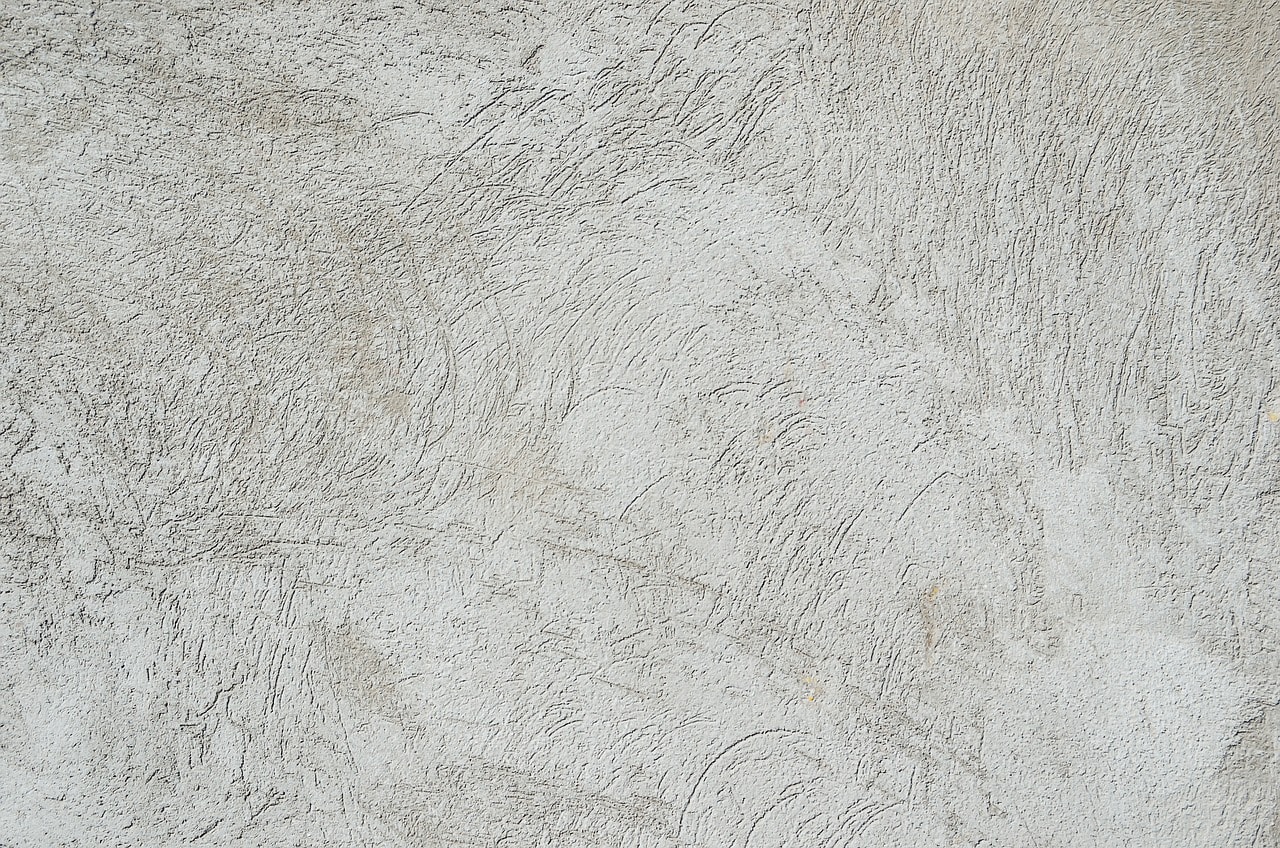
The alkaline pH of lime plaster makes it a desirable wall covering due to its adaptability, beauty, breathability, and eco-friendliness. Made from natural, biodegradable materials, it's a great choice for those who want to lessen their environmental footprint and live in humid conditions. However, lime plaster does not defend against environmental mould.
Gypsum plaster has its advantages and disadvantages as an interior wall covering. It works best in humid and rainy climates, and its installation necessitates experience and training. When compared to other common building materials, lime plaster stands out due to its adaptability, aesthetic appeal, and little carbon footprint.
Despite its high price, short shelf life, inaccessibility, need for specialised labour, and susceptibility to cracking, lime plaster remains a popular option for wall plastering. The first coat is the "scratch coat," which is the foundation, and the second coat is the "brown coat," which is the finishing layer.
Sanding the inside and outside of the wall, putting a thin coat of plaster, and following the manufacturer's instructions are all part of the wall preparation process. Grout should be the same colour as the plaster, and it is best if the orientation of the grout lines follows the grain of the wall.
Due to its density, stucco requires a thin grout layer to ensure continuity of design. Consider price, availability, required skill level, and desired aesthetics while picking a plaster.
Content Summary
- Plastering wall is an essential part of building or remodelling projects.
- Choosing the right plaster type is crucial for achieving desired results.
- Various types of plasters are available for wall plastering.
- Cement plaster, made of sand, cement, and water, is cost-effective and durable.
- Cement plaster is not suitable for period homes and lacks flexibility.
- The advantages of cement plaster include affordability, durability, versatility, water and fire resistance, and ease of application.
- Disadvantages of cement plaster include the potential for cracking, slow drying time, health concerns, difficult repairs, and limited design options.
- Gypsum plasters, made with gypsum, are more durable than calcium sulphate plasters.
- Natural, synthetic, and modified gypsum plasters are available.
- Adjustments can be made to gypsum mix based on climate conditions.
- Advantages of gypsum plaster include reduced shrinkage cracks, less supervision required, quick setting time, environmental friendliness, and a smooth finish.
- Disadvantages of gypsum plaster include vulnerability to chemical damage, unsuitability for wet areas, longer setting time, limited strength, and higher cost.
- Clay plaster is a natural and stylish option for wall plastering.
- Clay plaster is eco-friendly, provides good insulation, is easy to repair, regulates moisture, and offers a natural appearance.
- Disadvantages of clay plaster include vulnerability to water damage, susceptibility to cracking, longer drying time, and the need for skilled labour.
- Lime plaster is alkaline and improves paint adhesion and protection against atmospheric damage.
- The advantages of lime plaster include flexibility, aesthetic appeal, breathability, environmental friendliness, and ease of repair.
- Disadvantages of lime plaster include longer drying time, higher cost, limited availability, the need for skilled labour, and vulnerability to cracking.
- Factors to consider when choosing plaster include preventing damage, plaster application, wall preparation, grain direction, selection of grout, and budget.
- Plaster should be applied in two separate layers: scratch coat and brown coat.
- Walls should be prepared before plastering, including sanding the surface.
- Applying a thin layer of plaster helps in achieving a smooth surface.
- The scratch coat should be applied consistently with the wall's grain direction.
- Grout matching the plaster colour is recommended for easy cleaning.
- Budget considerations should be kept in mind when choosing plaster.
- Plastering helps make walls more resistant to wear and tear from the elements.
- Understanding the advantages and disadvantages of each plaster type is essential.
- Cement plaster is cost-effective and durable but has limitations in terms of flexibility and design options.
- Gypsum plaster offers reduced shrinkage cracks, quick setting time, and a smooth finish but is vulnerable to chemical damage and unsuitable for wet areas.
- Clay plaster is eco-friendly, regulates moisture, and provides a natural appearance, but it requires skilled labour and can be vulnerable to water damage.
- Lime plaster is flexible, aesthetically pleasing, breathable, and environmentally friendly but has a longer drying time, higher cost, and limited availability.
- Plaster application involves applying separate layers and using a damp cloth and trowel for a pleasing texture.
- Wall preparation includes sanding and applying a thin layer of plaster for a refined surface.
- Applying the scratch coat and second layer in the direction of the wall's grain ensures a smooth and attractive finish.
- Choosing grout that matches the plaster colour makes cleaning easier.
- Considering budget constraints is important when selecting plaster.
- The choice of plaster depends on factors such as cost, durability, aesthetics, and climate conditions.
FAQS About Wall Plastering
No, you cannot use any plaster for wall plastering. The type of plaster you should use will depend on the surface you are plastering and the desired finish.
For example, you may use a different type of plaster for interior walls than exterior walls and a different type for smooth finishes than textured ones. It's best to consult with a professional or a home improvement store to determine the right type of plaster for your specific needs.
The most commonly used plaster for wall plastering is gypsum plaster, also known as plaster of Paris. It is a smooth, white powder that can be mixed with water to create a paste that is easy to apply and dries quickly. Gypsum plaster is popular because it provides a smooth finish and can be easily sanded and painted. It is also fire-resistant and has good insulation properties.
The time it takes for the plaster to dry will depend on several factors, such as the type of plaster used, the thickness of the layer applied, and the temperature and humidity of the environment. However, plaster can generally take a few hours to several days to dry completely. Therefore, allowing the plaster to dry completely before sanding or painting is important to avoid damage or cracking.
Hiring a professional for wall plastering is unnecessary, but it can be beneficial. Plastering requires a certain level of skill and experience to achieve a smooth and even finish, especially for larger areas or more complex surfaces. If you need more experience or clarification about the process, hiring a professional can ensure a high-quality result and save time and effort.
However, if you have experience with DIY projects and are comfortable with the process, you can attempt wall plastering with proper research and preparation.
To seal the wall's surface perfectly, wood and metal require three coats of plastering. Stone and brick masonry generally require two coats for important constructions (public buildings, schools, etc.) and a single coat is done for low-cost construction.

